Walking Holidays in South West England
South West England offers some of the UK’s most spectacular long-distance walking. The South West Coast Path, England’s longest National Trail, follows 630 miles of dramatic shoreline from Minehead to Poole, passing rugged cliffs, golden beaches, and historic fishing villages along the way. Inland, the Two Moors Way provides a striking contrast, running coast to coast across Devon. This unforgettable journey takes you through rolling farmland, the remote beauty of Dartmoor and Exmoor, and the peaceful Mid Devon heartland. Whether you’re drawn to the ever-changing seascapes of the coast or the wild, open landscapes of the moors, South West England promises an adventure like no other.
The Dorset section of the South West Coast Path is a 76 mile walk from Lyme Regis to Poole along the Jurassic Coast. Passing through charming fishing villages, rocky headlands, and golden beaches, this route offers stunning coastal views as well as opportunities for fossil hunting.
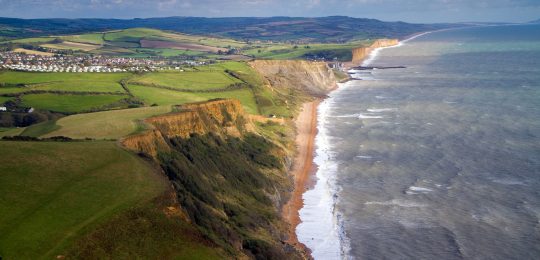
Our Dorset holiday delivers a memorable finale to the 630 mile South West Coast Path. This spectacular section of the trail offers not only stunning scenery but also remarkable geology, as it travels from Lyme Regis to Poole along the Jurassic Coast, England’s first Natural World Heritage Site.
The walk is full of striking natural features, including Charmouth Beach, where fossil hunters can search for traces of prehistoric life. Just nearby, you’ll find the spectacular viewpoint of Golden Cap, the highest point on the south coast of England, offering panoramic views over the coastline. For birdwatchers, West Bexington Nature Reserve provides a perfect spot to see migratory birds.
One of the route’s historical highlights is Thorncombe Beacon, part of a network of beacons used to warn of the approaching Spanish Armada in 1588. Close by, you’ll walk along the hauntingly beautiful Chesil Beach, a long pebble bay known for its shipwrecks and fascinating coastal geology. As you approach Lulworth, the iconic landmark of Durdle Door will captivate you with its natural limestone arch, one of the most photographed features on the coast.
Near Weymouth, you’ll have the choice to either stick to the coastal path or take a detour along the South Dorset Ridgeway, an ancient route through one of the UK’s most significant ceremonial landscapes, offering a glimpse into Britain’s distant past.
Whether the Dorset coast is the home straight on an epic South West Coast Path adventure, or perhaps your introduction to this iconic walk, or even something in between, you’re sure to experience a walk filled with history, stunning views, and a wealth of natural beauty that will leave you with lasting memories.
Length
7 - 8 nights
Full Route Length
76 miles / 122 km
Average Grade
Moderate
Why do this walk?
Explore along the Jurassic Coast, England's first World Heritage Site.
Enjoy dramatic clifftop walking between delightful sandy beaches.
Stay in pretty seaside towns and picturesque fishing villages.
Look out for seabirds at West Bexington Nature Reserve and along the cliffs.
Visit Durdle Door, Chesil Beach, and the dramatic Lulworth Cove.
Walk the South Dorset Ridgeway, home to prehistoric burial mounds.
The North Cornwall section of the South West Coast Path stretches 144 miles from Westward Ho! to St Ives. Passing through tiny fishing villages and popular towns such as Tintagel, Padstow and Newquay, this route offers breathtaking coastal scenery and a chance to explore Cornwall’s rich maritime history.
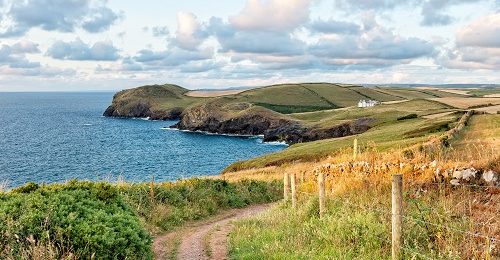
Our North Cornwall holidays cover over 140 miles of coastline from Westward Ho! to St Ives, taking you through charming fishing villages with cobbled streets, ancient woodlands, rocky headlands, remote landscapes, and golden surf-washed beaches.
You’ll enjoy overnight stays in the popular towns such as Tintagel, Port Isaac, Padstow and of course St Ives itself. Along the way, you’ll discover many historical sites, as well as museums telling the story of North Cornwall’s hidden past. Key highlights along this stunning stretch of coast include Tintagel Castle, the mythical birthplace of the legendary King Arthur. There are a number of Iron Age forts which are of huge interest too. Also on display are abandoned engine houses, relics of a once prosperous tin mining industry.
The first half of the North Cornwall coast features some the wildest and remotest areas on the whole of the South West Coast Path. As a result, the walking can be challenging at times. Be prepared for numerous daily ascents and descents. The second half introduces Cornwall’s famous surfer beaches, adding a lively contrast to the rugged terrain.
This dramatic landscape features magnificent waterfalls crashing from clifftops onto rocky beaches below. Wildlife sightings are common, with grey seals often spotted along the coast. Birdwatchers will be delighted by stonechats, linnets, and meadow pipits, as well as peregrine falcons, buzzards, and kestrels. The colourful flora, including cornflowers, sea pinks, and kidney vetch, enhances your journey through this awe-inspiring coastline.
Length
5-10 Nights
Full Route Length
144 miles / 230 km
Shortest Break Length
64 miles / 103 km
Average Grade
Moderate
Why do this walk?
Discover Cornwall’s rugged headlands and dramatic cliffs.
Explore Tintagel Castle, Iron Age forts, and remnants of Cornwall’s tin mining history.
Pass by golden surf-washed sands and Cornwall’s top surfing spots.
Spot grey seals, peregrine falcons, and a variety of coastal birds.
Wander through quaint fishing villages, and picturesque towns like Padstow and St Ives.
Admire the vibrant wildflowers that colour the landscape throughout the year.
The North Devon section of the South West Coast Path is an 88 mile walk from Minehead to Westward Ho! With the highest cliffs in England, stunning beaches, and a wealth of flora and fauna, this route offers panoramic coastal views and an insight to the region’s maritime past.
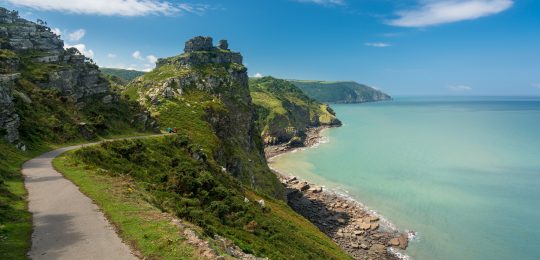
Our North Devon holiday, the first leg of the 630 mile South West Coast Path, actually begins just over the border in Somerset, in the town of Minehead. From here, you’ll follow the coastal path for almost 90 miles to the village of Westward Ho! with overnight stays in popular locations such as Lynmouth, Ilfracombe, and Woolacombe.
This section of the South West Coast Path offers diverse and dramatic scenery. The first stretch takes you along some of the highest cliffs in England, where the wild beauty of Exmoor meets the sea. You’ll enjoy expansive views inland and north across the Bristol Channel, with the coast of Wales as a distant backdrop. The trail passes through coastal woodlands, stretches of sandy beaches popular with surfers, and the large estuary of the Taw and Torridge rivers, flanked by sand dunes and marshland. Here, the path follows the route of the former railway and the river estuary.
On your journey you’ll be greeted by the sight of numerous clifftop flowers, particularly the abundance of bluebells and primroses in spring. The Exmoor coast is home to a variety of wildlife and many rare species of flora and fauna. Look out for red deer, stag beetles, blackneck moths and the whitebeam trees which are unique to Exmoor.
There are Sites of Special Scientific Interest with their delightful heathland and grasses. Nature reserves too with sand dunes housing rare snails and lizards, as well designated areas of Outstanding Natural Beauty where you might spot grey seals, gannets, and in summer, even dolphins, sunfish and basking sharks.
This stretch of coastline is particularly valued for its birdlife. It also incorporates the Tarka Trail, a series of footpaths following the route of Tarka the Otter, as told in the book by Henry Williamson.
Length
8 to 10 nights
Full Route Length
88 miles / 142 km
Average Grade
Moderate
Why do this walk?
Walk along some of England’s highest cliffs with sweeping views across the Bristol Channel.
Explore diverse landscapes, from sandy beaches to tranquil estuaries and coastal woodlands.
Enjoy vibrant springtime flowers, with bluebells and primroses carpeting the coastal paths.
Pass through protected nature reserves, home to rare snails, lizards, and coastal birds.
Experience the beauty of North Devon’s marine life, from grey seals to dolphins and seabirds.
Follow the Tarka Trail, a literary journey through the land of Tarka the Otter.
The South and West Cornwall section of the South West Coast Path covers 178 miles from St Ives to Plymouth. This stretch takes in beautiful beaches, a wealth of flora and fauna, and offers a glimpse into Cornwall’s fascinating history of seafaring and smugglers.
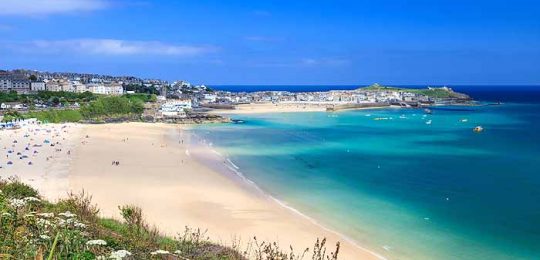
The South and West Cornwall coastline is the longest section of the South West Coast Path, stretching 175 miles from St Ives to Plymouth. This diverse coastline offers a mix of rocky headlands overlooking idyllic coastal villages, lively resorts with magnificent sandy beaches, and dramatic cliffs that shape the landscape. In addition to being bookended by the popular towns of St Ives and Plymouth, overnight stays include Penzance and Falmouth.
Much of the trail follows the footpaths once used by 19th-century coastguards, who were on the lookout for smugglers. Popular highlights include Gurnard’s Head, Sennen Cove, St Michael’s Mount, the Minack Theatre, and the magnificent Lizard Point. Along the way, you’ll encounter numerous historical sites, including tin-mine ruins, coastguard lookouts, lighthouses, ancient harbours, and age-old churches.
Boulder-strewn cliffs, smugglers’ coves, windswept headlands, and sweeping views all contribute to this dramatic landscape, while colourful wildflowers and a wealth of birdlife enhance the experience. Look out for fulmars, kittiwakes, shags, razorbills, and the Cornish chough, once extinct in the county but now making a welcome return.
Whether you choose to complete this stretch of the South West Coast Path in a series of short breaks or as one combined challenge, you’re assured of a rich and rewarding experience, with plenty of time to soak in the beauty and history of this remarkable coastline.
Length
4 - 8 Nights
Full Route Length
178 miles / 280km
Shortest Break Length
39 miles / 63 km
Average Grade
Moderate
Why do this walk?
Visit ancient tin mines, smugglers’ coves, lighthouses, and historic harbours.
Enjoy breathtaking views over cliffs and out to the Atlantic Ocean.
Follow the 19th-century footpaths once used to spot smugglers.
Spot Cornish chough, fulmars, razorbills, and an abundance of seabirds.
Marvel at Cornwall’s iconic landmarks like Gurnard’s Head, Kynance Cove and Lizard Point.
Experience vibrant wildflower displays that bring the landscape to life.
The South Devon section of the South West Coast Path stretches 131 miles from Plymouth to Lyme Regis along the Jurassic Coast. This section takes in tiny fishing villages, rocky headlands, lively resorts and golden surf-washed beaches.
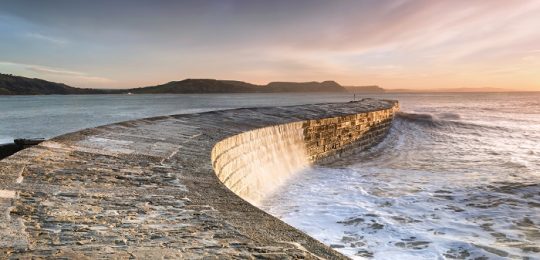
Our South Devon holidays are as diverse as they are delightful, with 125 miles of truly unforgettable coastline. Bookended by Plymouth, where the Pilgrim Fathers departed for the New World in 1620, and Lyme Regis, renowned for its World Heritage Jurassic Coast, this section offers both historical significance and breathtaking beauty.
On your journey you’ll enjoy idyllic coastal villages, golden surf-washed beaches and rocky headlands rewarding you with incredible views. Take time to soak up the atmosphere of the lively resorts on the English Riviera. Quiet time is guaranteed too as you pass through ancient woodlands and visit peaceful coves.
With its many National Nature Reserves and Sites of Special Scientific Interest, South Devon is incredibly rich in flora and fauna. Wildlife and birdlife are plentiful too and you never know, you might spot dolphins or other marine life along the way. You’ll also explore sections of the Jurassic Coast where you can try your hand at fossil hunting. For those with an industrial interest, there are miles of Brunelian railway line, lighthouses, wartime defences and an ill-fated abandoned village.
However you choose to explore the South Devon Coast, either a full on fortnight for the entire route, or nice and steady over several visits, our holidays promise a rewarding experience, filled with natural beauty, fascinating history, and memories that will last a lifetime.
Length
3 - 7 nights
Full Route Length
131 miles / 211 km
Shortest Break Length
28 miles / 45 km
Average Grade
Moderate
Why do this walk?
Explore the Jurassic Coast, England's first World Heritage Site.
Enjoy the mild and sunny climate of the English Riviera.
Visit the many National Nature Reserves and Sites of Special Scientific Interest.
Marvel at South Devon’s natural beauty, from rocky headlands to golden beaches.
Explore lively resorts with sandy beaches, perfect for a blend of relaxation and adventure.
Discover South Devon’s history with Brunel’s railway line and wartime defences.
The Two Moors Way is a 117 mile coast-to-coast walk from Wembury to Lynmouth. Traversing the wilds of Dartmoor and Exmoor National Parks, the route passes through lush valleys, high moorland, and picturesque countryside, offering a rich mix of natural beauty and history as it crosses the heart of Devon.
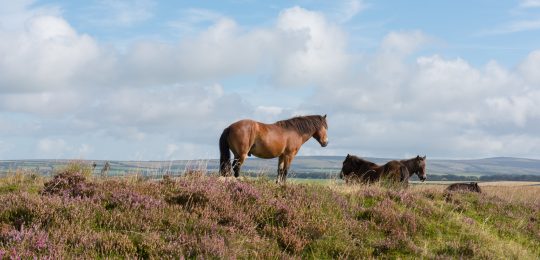
The Two Moors Way is a true showcase of Devon’s rural heart and wild landscapes. Stretching 117 miles from Wembury on the South Devon coast to Lynmouth on the North Devon coast, this remarkable route links the rugged granite tors of Dartmoor with the rolling heathlands of Exmoor.
Beginning at Wembury Bay, and following a section of the Erme-Plym Trail, the route leads you through the tranquil South Hams countryside, known for its rolling green fields and timeless villages. The first stages provide a gentle introduction to Devon’s softer, more pastoral side, before reaching the original start of the Two Moors Way at Ivybridge and making your way north toward Dartmoor’s dramatic uplands.
Dartmoor is often described as one of England’s last wildernesses, a vast expanse of open moorland dominated by craggy tors, ancient woodlands, and a rich archaeological landscape. Here, the route takes you across its southern reaches, offering a blend of panoramic views, remote paths, and atmospheric stretches where wild ponies and sheep are your most common companions. The moor is as inspiring as it is challenging, with weather that can turn in an instant, demanding both resilience and careful preparation. Ensure you have your compass to hand.
Between Dartmoor and Exmoor, the Two Moors Way threads through the peaceful and little-walked Mid Devon heartland, a region of quiet farmland, scattered woodlands, and traditional villages. This middle section of the trail contrasts beautifully with the surrounding wilderness, offering temporary respite and immersion in the rural tranquility of the Devon countryside.
Then comes Exmoor, a landscape that is both wild and inviting. As you approach its southern slopes, the scenery shifts again, with steep wooded valleys, high open moors, and tumbling rivers carving their way to the sea. The final leg of the route leads you to Lynmouth, where the dramatic coastline of North Devon greets you with sweeping views, and rewards you with a real sense of achievement.
Quite simply, from the quiet woods to the wild moors and onward to the sea, the Two Moors Way is an unforgettable adventure through some of the finest landscapes in the southwest.
Length
5 - 13 nights
Full Route Length
117 miles / 188 km
Shortest Break Length
51 miles / 82 km
Average Grade
Moderate to Challenging
Why do this walk?
Traverse Devon from coast to coast on an inspiring route through the county’s most diverse landscapes.
Experience the tranquil beauty of the South Hams, with its rolling fields and charming villages.
Wander through the vast, open wilderness of Dartmoor National Park, exploring its iconic granite tors and wild moorland.
Cross the stunning Exmoor National Park, where rugged hills meet dramatic coastal views.
Walk through picturesque river valleys, including the Barle and Dart, where wildlife thrives in peaceful surroundings.
Revel in the solitude of Mid Devon’s remote countryside, with its quiet woodlands and sleepy hamlets.





